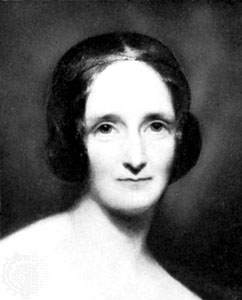Mary Shelley, author of the most notable gothic novel of all times, inspires authors who read her work. Mary Shelley’s professional life as her husband’s editor, a novelist, and a poet began in 1816, in Scotland when she began her first novel. First of all, while Mary Shelley visited her family in England, Shelley became an acquaintance to the poet Percy Bysshe Shelley, and later became his wife (Walling 9) and full time editor.
As Percy Shelley’s reviser, she promoted the understanding of his works, which led to the history of biographical-literary criticism (Spark ix).  Shelley traveled frequently, once to Italy in 1818, where she composed Italian Lives, which appeared in Lardner’s Cabinet Cyclopedia (Walling 10). Shelley’s marriage persisted for eight years (Spark ix), which ended on July 8, 1822 when Percy Shelley drown (Walling 10), and left her a single mother of a child, and a son on the way (Spark ix). Second, Mary Shelley achieved her highest acknowledgments for her writings and gothic novels. Shelley began her first novel Frankenstein (Thompson 2), at nineteen years of age in the summer of 1816 and publicized it on March 11, 1818 (Walling 9).
Shelley traveled frequently, once to Italy in 1818, where she composed Italian Lives, which appeared in Lardner’s Cabinet Cyclopedia (Walling 10). Shelley’s marriage persisted for eight years (Spark ix), which ended on July 8, 1822 when Percy Shelley drown (Walling 10), and left her a single mother of a child, and a son on the way (Spark ix). Second, Mary Shelley achieved her highest acknowledgments for her writings and gothic novels. Shelley began her first novel Frankenstein (Thompson 2), at nineteen years of age in the summer of 1816 and publicized it on March 11, 1818 (Walling 9).
The horror novel received numerous reviews and became one of the literary events of 1818 (Walling 34). Shelley wrote five other novels in her lifetime including The Last Man (Walling 72) and Valpera. The Last Man, published in 1826 (Walling 10), and Frankenstein are Shelley’s two most sought novels, and William Walling observes that they are “two novels whose loneliness is final Mensik 2 and irreparable” (86). Valperga, published in 1823, received reviews with modern critics that were not as highly ranked as the others. Shelley first began Valperga in 1817, however, she completed the novella in 1821, during which Shelley went through a marriage crisis with her husband Percy Shelley and mourned over the loss of two children (Walling 52). Walling observes that Shelley’s other novelettes were Matilda, completed in 1819, Perkin Warbeck, published in 1830, Lodore, published in 1835, and Falker, published in 1837. Society also granted fame to Mary Shelley for her intriguing poetry. In 1822, Shelley wrote her first poem, “The Choice”. Shelley’s release of Shelley’s Prometheus Poems in 1824 sold more than three hundred copies (10). Over all, Mary Shelley accomplished numerous goals in her life and earned respect as an author. Mary Shelley composed countless invigorating novels and poems throughout her life and will remain widely known for Frankenstein. Muriel Spark comments, “[Frankenstein] was the first of a new hybrid fictional species,” (11). Horror novelist will always look to her work for inspiration.
Works Consulted
“Arguments Through the Ages”. Startribune. 27 Dec 1999. 3. ProQuest. Access 6 Jan 2000. Bloom, Harold. Mary Shelley. New York: Chelsea House, 1985. Spark, Muriel. Mary Shelley. New York: Dutton, 1987. Thompson, Terry. “Shelley’s Frankenstein”. The Explicator. 1999. 4. ProQuest. Access 6 Jan 2000. Walling, William. Mary Shelley. Boston: Twayne, 1972.
